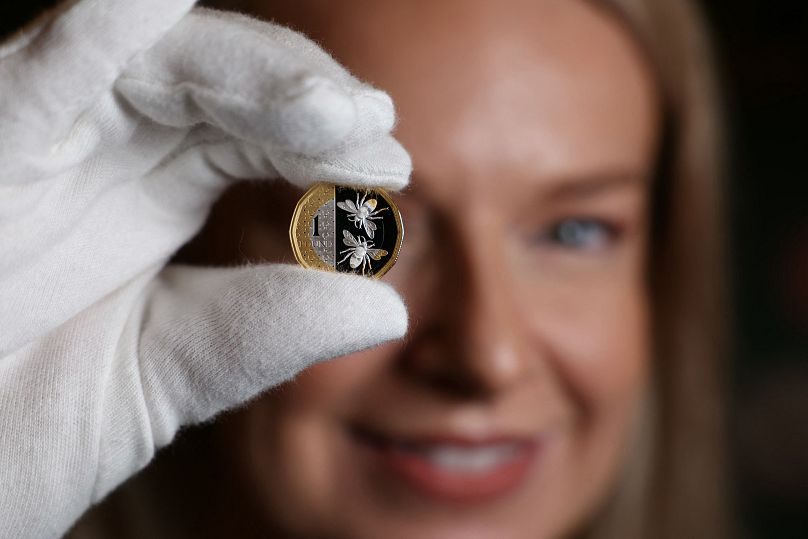Euronews Business compares the different savings challenges to set out what might be suited to you.
With 2024 coming up fast, savings challenges are once again gaining momentum. While these challenges can certainly be fun and quirky for some, several others may also see them as too difficult to stick to, or just too complicated.
However, they don’t necessarily have to be! Euronews Business weighs some of the more popular savings challenges, so you can hopefully pick out one that works best for you.
Please keep in mind that these challenges should ideally not replace your regular saving habits, but should be seen as an added bonus, taken from curbing daily expenditures.
30-day challenge- total €100
The 30-day savings challenge is one of the easier ones on this list. It could be a way of stashing away a little extra cash for special occasions or a particular goal, if a longer challenge is too much to commit to.
It starts with saving €1 for the first five days, then €2 for the next five days, €3 for the next five days and €4 for the next five. For the last ten days, you save €5 a day. This gives you a total of €100 at the end of the 30 days and you can then restart the challenge in the next month, if it works for you.
For months with 31 days, you can choose to take a break on the last day, stick to the €5 for that day as well, or even, deposit a little more as a special treat, like €10 or similar.
I tried this challenge myself, and found it surprisingly easy to stick to, as well as providing a comforting sense of routine and something to look forward to! I used to set a daily alarm to remind myself, usually at a time when I knew I’d be relatively free, like 3pm. However, once it became a part of my daily routine, I found myself not really needing the alarm after all, and doing it in the mornings most days.
On some days, I realised I made 2 transactions, having forgotten about the first one, since I usually didn’t wait for the alarm. This mainly happened on days I was travelling or when I was extra busy. The challenge saves around €1,200 a year, which may be fine for some, but if you’re looking to save a more substantial amount, you may need to modify it yourself, or opt for a more rigorous one.
Some people also choose to do the challenge in reverse, so starting with €5 for the first ten days, and then counting down backwards till day 30.
A twist on the 30-day challenge
For savers who’d like a bit more of a payout at the end of the month (or year), you can also opt to break down the 30-day challenge into weekly chunks. Say you start it on a Sunday, you’d save €1 on Sunday, €2 on Monday, €3 on Tuesday and so on until €7 on Saturday.
Then start again for the following week. This gives you €112 at the end of the month, or around €1,344 at the end of the year.
€1 challenge-total €365
The €1 challenge is quite possibly the easiest one on this list and involves saving € 1 every day to hit €365 at the end of the year. This may be great for younger savers who may not have too much disposable income, or for people looking to build up a regular savings habit, before pushing themselves to do more.
1 cent challenge-total €667.95
The 1 cent challenge can be seen as a variation of the €1 challenge, in the sense that instead of saving €1 every day of the year, it actually starts by saving 1 cent on the first day. Then 2 cents on the second, three cents on the third, all the way up till €3.65 on the 365th day, giving you a grand total of €667.95.
Most people start this one on the 1 January, but it can just as easily be started on any other day as well, as long as you keep track. The main appeal of this challenge remains that although the amounts are significantly more towards the end of the year, they are not too demanding, but yield almost twice as much as the €1 challenge.
The 52-week challenge- total €1,378
The 52-week challenge remains one of the most undertaken savings challenges, especially since it is a weekly, rather than daily one. As such, in the first week, you save €1, in the second, €2, up till €52 in the last week of the year, for a total of €1,378.
However, because of the considerably higher contributions at the end of the year, this challenge is also one of the most abandoned towards the tail end. As such, it may not be suitable for people with irregular incomes, or those who may not be not be able to commit to the larger weekly amounts at the end of the year. Increased holiday and festive expenses during this time may also make it somewhat harder to stick to.
Some people also find it easier to start the 52-week challenge in reverse, so saving €52 in the first week of January and so on, until the smallest amounts fall at the end of the year. This can go a long way in helping manage and balance out holiday expenses, while also helping you stick to the challenge.
12-month savings challenge- total €780
The 12-month savings challenge is a monthly one, starting with €10 in January, €20 in February, all the way up to €120 in December. The amounts are fairly modest, making it a relatively easy one to stick to, especially for a special goal or event.
€5 challenge- total €7,000
The €5 challenge is one of the most rigorous ones, suitable for a specific large goal, such as a car, house deposit, fancy holiday, wedding or similar. A number of people like to also do this in pairs with their partners or even groups, as it makes the goal a little easier to achieve.
Also a weekly challenge, the first week you save €5, the second week €10, all the way up until €260 in the 52nd week. However, this may be more suited for people with higher disposable incomes, or savers with more established savings habits, as the amounts later on in the year may be quite hard to reach.
Several people also slightly tweak the later amounts, so that they’re not quite so out of reach, and they still manage to save a significant amount by the end of the year.
Essentials challenge
The essentials challenge is one where you basically only spend on essential items over a period, such as groceries, bills, transport, toiletries, etc. Luxury or nice-to-have items such as coffee shop drinks, concert tickets, eating out and streaming services are all cut out. This challenge can be undertaken over a weekend, or a week or even a month, depending on person to person.
This can be done more as an attempt to reset your finances, especially after periods of excessive spending, such as the holidays, or a trip.
This information does not constitute financial advice, always do your own research on top to ensure it's right for your specific circumstances. Also remember, we are a journalistic website and aim to provide the best guides, tips and advice from experts. If you rely on the information on this page then you do so entirely at your own risk.
You can also come up with your own savings challenge, based on whatever you like, such as lucky numbers, seasonal trends, special events, group challenges and much more!




